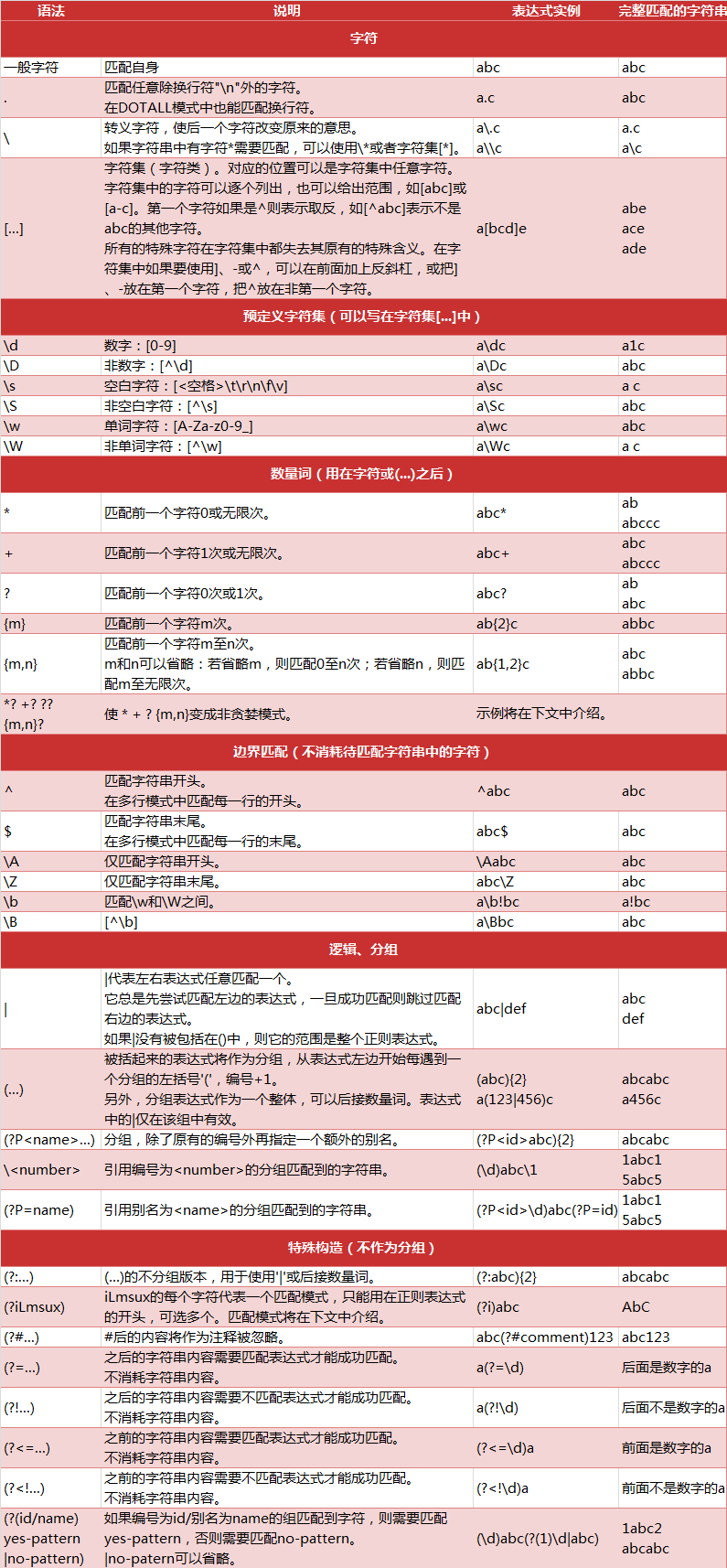Python正则表达式
使用正则表达式,会使得字符串的处理很方便。
正则表达式基础
常用语法
Python中经常要对字符串进行处理,处理用户的输入,对文本的编辑等等。使用正则表达式,会使得字符串的处理很方便。
数量词的贪婪模式与非贪婪模式
正则表达式通常用于在文本中查找匹配的字符串。
Python里数量词默认是贪婪的(在少数语言里也可能是默认非贪婪),总是尝试匹配尽可能多的字符;非贪婪的则相反,总是尝试匹配尽可能少的字符。
例如:正则表达式”ab“如果用于查找”abbbc”,将找到”abbb”。而如果使用非贪婪的数量词”ab?”,将找到”a”。
re模块
开始使用re
Python通过re模块提供对正则表达式的支持。使用re的一般步骤是先将正则表达式的字符串形式编译为Pattern实例,然后使用Pattern实例处理文本并获得匹配结果(一个Match实例),最后使用Match实例获得信息,进行其他的操作。
1 | # encoding: UTF-8 |
re.compile(strPattern[, flag]):
这个方法用于将字符串形式的正则表达式编译为Pattern对象, 第二个参数flag是匹配模式,取值可以使用按位或运算符’|’表示同时生效,比如re.I | re.M。另外,你也可以在regex字符串中指定模式,比如re.compile(‘pattern’, re.I | re.M)与re.compile(‘(?im)pattern’)是等价的。
可选值有:
- re.I(re.IGNORECASE): 忽略大小写(括号内是完整写法,下同)
- M(MULTILINE): 多行模式,改变’^’和’$’的行为(参见上图)
- S(DOTALL): 点任意匹配模式,改变’.’的行为
- L(LOCALE): 使预定字符类 \w \W \b \B \s \S 取决于当前区域设定
- U(UNICODE): 使预定字符类 \w \W \b \B \s \S \d \D 取决于unicode定义的字符属性
- X(VERBOSE): 详细模式。这个模式下正则表达式可以是多行,忽略空白字符,并可以加入注释。以下两个正则表达式是等价的:
1
2
3
4a = re.compile(r"""\d + # the integral part
\. # the decimal point
\d * # some fractional digits""", re.X)
b = re.compile(r"\d+\.\d*")
re提供了众多模块方法用于完成正则表达式的功能。这些方法可以使用Pattern实例的相应方法替代,唯一的好处是少写一行re.compile()代码,但同时也无法复用编译后的Pattern对象。1
2m = re.match(r'hello', 'hello world!')
print m.group()
re模块还提供了一个方法escape(string),用于将string中的正则表达式元字符如*/+/?等之前加上转义符再返回,在需要大量匹配元字符时有那么一点用。
Match
Match对象是一次匹配的结果,包含了很多关于此次匹配的信息,可以使用Match提供的可读属性或方法来获取这些信息。
属性:
- string: 匹配时使用的文本。
- re: 匹配时使用的Pattern对象。
- pos: 文本中正则表达式开始搜索的索引。值与Pattern.match()和Pattern.seach()方法的同名参数相同。
- endpos: 文本中正则表达式结束搜索的索引。值与Pattern.match()和Pattern.seach()方法的同名参数相同。
- lastindex: 最后一个被捕获的分组在文本中的索引。如果没有被捕获的分组,将为None。
- lastgroup: 最后一个被捕获的分组的别名。如果这个分组没有别名或者没有被捕获的分组,将为None。
方法:
- group([group1, …]):
获得一个或多个分组截获的字符串;指定多个参数时将以元组形式返回。group1可以使用编号也可以使用别名;编号0代表整个匹配的子串;不填写参数时,返回group(0);没有截获字符串的组返回None;截获了多次的组返回最后一次截获的子串。 - groups([default]):
以元组形式返回全部分组截获的字符串。相当于调用group(1,2,…last)。default表示没有截获字符串的组以这个值替代,默认为None。 - groupdict([default]):
返回以有别名的组的别名为键、以该组截获的子串为值的字典,没有别名的组不包含在内。default含义同上。 - start([group]):
返回指定的组截获的子串在string中的起始索引(子串第一个字符的索引)。group默认值为0。 - end([group]):
返回指定的组截获的子串在string中的结束索引(子串最后一个字符的索引+1)。group默认值为0。 - span([group]):
返回(start(group), end(group))。 - expand(template):
将匹配到的分组代入template中然后返回。template中可以使用\id或\g、\g 引用分组,但不能使用编号0。\id与\g 是等价的;但\10将被认为是第10个分组,如果你想表达\1之后是字符’0’,只能使用\g<1>0。
1 | import re |
输出内容如下:1
2
3
4
5
6
7
8
9
10
11
12
13m.string: hello world!
m.re: re.compile('(\\w+) (\\w+)(?P<sign>.*)')
m.pos: 0
m.endpos: 12
m.lastindex: 3
m.lastgroup: sign
m.group(1,2): ('hello', 'world')
m.groups(): ('hello', 'world', '!')
m.groupdict(): {'sign': '!'}
m.start(2): 6
m.end(2): 11
m.span(2): (6, 11)
m.expand(r'\2 \1\3'): world hello!
Pattern
Pattern对象是一个编译好的正则表达式,通过Pattern提供的一系列方法可以对文本进行匹配查找。
Pattern不能直接实例化,必须使用re.compile()进行构造。
Pattern提供了几个可读属性用于获取表达式的相关信息:
- pattern: 编译时用的表达式字符串。
- flags: 编译时用的匹配模式。数字形式。
- groups: 表达式中分组的数量。
- groupindex: 以表达式中有别名的组的别名为键、以该组对应的编号为值的字典,没有别名的组不包含在内。
1 | import re |
实例方法[ | re模块方法]:
match(string[, pos[, endpos]]) | re.match(pattern, string[, flags]):
这个方法将从string的pos下标处起尝试匹配pattern;如果pattern结束时仍可匹配,则返回一个Match对象;如果匹配过程中pattern无法匹配,或者匹配未结束就已到达endpos,则返回None。
pos和endpos的默认值分别为0和len(string);
re.match()无法指定这两个参数,参数flags用于编译pattern时指定匹配模式。
注意:这个方法并不是完全匹配。当pattern结束时若string还有剩余字符,仍然视为成功。想要完全匹配,可以在表达式末尾加上边界匹配符’$’。search(string[, pos[, endpos]]) | re.search(pattern, string[, flags]):
这个方法用于查找字符串中可以匹配成功的子串。从string的pos下标处起尝试匹配pattern,如果pattern结束时仍可匹配,则返回一个Match对象;
若无法匹配,则将pos加1后重新尝试匹配;直到pos=endpos时仍无法匹配则返回None。
pos和endpos的默认值分别为0和len(string));re.search()无法指定这两个参数,参数flags用于编译pattern时指定匹配模式。
1 | # encoding: UTF-8 |
- split(string[, maxsplit]) | re.split(pattern, string[, maxsplit]):
按照能够匹配的子串将string分割后返回列表。maxsplit用于指定最大分割次数,不指定将全部分割。
1 | import re |
- findall(string[, pos[, endpos]]) | re.findall(pattern, string[, flags]):
搜索string,以列表形式返回全部能匹配的子串。
1 | import re |
- finditer(string[, pos[, endpos]]) | re.finditer(pattern, string[, flags]):
搜索string,返回一个顺序访问每一个匹配结果(Match对象)的迭代器。
1 | import re |
- sub(repl, string[, count]) | re.sub(pattern, repl, string[, count]):
使用repl替换string中每一个匹配的子串后返回替换后的字符串。
当repl是一个字符串时,可以使用\id或\g、\g 引用分组,但不能使用编号0。
当repl是一个方法时,这个方法应当只接受一个参数(Match对象),并返回一个字符串用于替换(返回的字符串中不能再引用分组)。
count用于指定最多替换次数,不指定时全部替换。
1 | import re |
- subn(repl, string[, count]) |re.sub(pattern, repl, string[, count]):
返回 (sub(repl, string[, count]), 替换次数)。
1 | import re |
以上就是Python对于正则表达式的支持。熟练掌握正则表达式是每一个程序员必须具备的技能。笔者也是看的迷迷糊糊,文章来自cnblog,原版博客基于Python2.4完成,年代有点久,我稍微修改了一下代码。
Python正则表达式